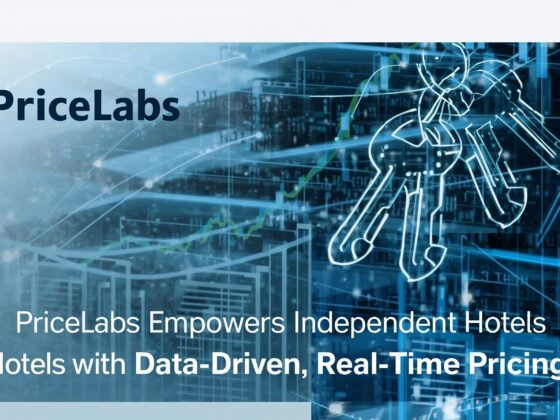How to deal with the slow death of attribution and tracking? Behind the scenes of citizenM’s brand sale. Toblerone instead of towels. And more
Hello,
I realize I talk a lot about AI. Probably that’s because it’s the most exciting thing happening in technology right now. Its impact on marketing is obvious, its impact on hotels much less so. But if we’re not aware of what’s happening, then it’s going to be hard to adapt when the change is everywhere. Now let’s get into the newsletter.
Best, Martin
Sponsored by Klairhaus. Support the newsletter, treat someone to great office gadgets.
Behind the PR, citizenM’s sale to Marriott
Matthias H interviewed Lennert De Jong the CEO of citizenM in a 3 part interview about the story behind the sale of the brand to Marriott and a lot more. It is a brilliant conversation on how the sale happened. Both of them are known to speak their minds, even discusses what is probably the most innovative hotel loyalty system. Will citizenM’s culture manage to percolate into the Marriott behemoth?
HOSPITALITY DAILY PART1 PART2 PART3
AI could help hotels generate more direct
There’s a small possibility for hotels to rapidly get a leg up and get their websites well indexed in AI tools. Of course OTAs have massive dynamic datasets. But hotels have a chance to get their sites indexed with a lot of additional data, imagery, content, context and more. But it will take a lot of first movers and investment.
AI AND OTA DEPENDENCE
About me: I'm a fractional CMO for large travel technology companies helping turn them into industry leaders. I'm also the co-founder of 10minutes.news a hotel news media that is unsensational, factual and keeps hoteliers updated on the industry. The biggest risk with AI is “god””
As humans we are often tend towards the path of least resistance. With AI that could be a problem. If anything, we need to learn much much more about critical thinking. The fact that AI companies are making their chatbots act like people (anthropomorphizing) doesn’t help. Search engines at least left some thinking to people, AI doesn’t. It might be a good idea to regulate that these machines act like machines and not people.
CHATGPT AI RELIGION AI COMMERCE SEARCH
Like this? Share it!
TikTok, the New Frontier for Retail Sales?
According to this report, in 2023, over 60% of retail sales were digitally influenced, this figure expected to rise to 70% by 2027. L’Oréal’s success with AR try-on sessions exemplifies the potential of digital touchpoints. In the west nobody has cracked social selling like Tiktok is managing. Could this become a direct channel? Hotels have the upper-hand if they can make good content.
DIGITAL RETAIL INFLUENCE
Swapping towels for Toblerone
During covid a trend emerged of not cleaning rooms if the guest had not requested it the day before. It was absurd. And the prices didn’t go down. Some hotels donated to charity, others didn’t. At the time I commented that the gap between hotels and rentals was shrinking. Luckily that is over now. But this idea of giving the guest something from the minibar if they don’t change the towels is a lot smarter. At least we have the choice. Plus a great newsletter to read.
HOTEL NUGGETS TRAVELER AMENITIES
Expensify’s $40M F1 Movie Investment
Expensify invested $40 million in product placement for the F1 movie, expecting a 5:1 return on investment. This included naming a team “Expensify APX GP” and featuring the brand quite prominently. Product placement and in-movie sponsorships isn’t new. But as a lot of the old ad channels are shifting this is yet another channel to use. But it is limited to the few.
EXPENSIFY F1 INVESTMENT
Podcast: I was invited on the Hospitality Daily Podcast and spoke about technology in hospitality, some thoughts on what wont change in hospitality, and why I co-founded 10minutes.news. Opinion
Marketing’s obsession with tracking
Recent changes by Apple are sending a bunch of marketers into a frenzy (again). UTMs might be cut off, attribution windows might shrink, and everyone’s scrambling to figure out how they’ll “track the funnel.” It’s like every year we’re surprised that privacy is making tracking harder, and yet somehow we still act shocked.
I’ve had more discussions I can count related to, “Yeah, but is our tracking really correct?” At some point, I had to stop and ask, “What are we actually trying to prove here?” I remember a campaign we launched for a client, not even a particularly flashy one, just a solid offer and a well-written message. Within a week, lead volume had jumped 20%. It was enough of an indicator that this was working. But instead of seeing that success and expanding from there, meetings spent hours trying to verify the tracking and if the leads really came from that campaign. Concluding that we needed to invest into a more solid tracking system.
We were losing time arguing about the time, the ad, the bid, the platform that caused each lead, instead of doing more of what was clearly working. Marketing became less about action and more tracking technology.
Somewhere between the invention of the UTM tag and the rise of attribution models, we turned marketers into spreadsheet fanatics, in search for “perfect tracking.” Clicks, conversions, ROAS, and 34 other acronyms now rule the dashboards. The problem? We can’t see the forest behind the tracking tree, and forgot why we’re here in the first place.
Yes, tracking is useful. But if you spend more time debugging analytics tools than crafting campaigns, something is off. “The tracking isn’t working” has become the go-to excuse for lack of competence in marketing (spolier: the tracking will never work).
Some of the most effective marketing in history happened before we had any tracking at all. You don’t need click-level granularity to see that brand search went up after a campaign. That’s signal. Leads dropping off even though ad spend is increasing? Also signal. Cross-referencing a few metrics such as brand queries vs form fills vs pipeline can tell you a lot. You just need curiosity, correlation, and a bit of imagination.
And to quote Goodhart’s Law “When a measure becomes a target, it ceases to be a good measure.” When we only follow the numbers, we often stop listening to what the numbers mean. (I know, this applies to a lot more than just marketing).
So yes, Apple is cutting off UTMs. Tracking will get fuzzier. But maybe that’s a good thing. Maybe it forces us to return to logic, testing, iteration, and simple common sense. To rely less on attribution software and more on observation. Marketing is not about instrumentation – it’s about moving people.
Let’s not forget that.
PS: Here’s a tip to spot someone who is hiding behind the tracking and KPIs: the KPIs they present over time are always different. i.e. One month it is Website visitors, the next month it is email open rate. You need less than a handful of KPIs to know how things are going – ensure they’re always the same ones presented in the same manner.
• A compendium of tech-related laws, fallacies, and other wisdom – Link
• Influencer PR Kits That Rock – Link
• Hospitality Design Trends Benchmark – Link⁺
• The Hotel Distribution Tech Chart version 2026 – Link⁺
⁺ Note, articles that are published by companies or people I work with are tagged with the ⁺ symbol or Partner word. I’m adding this as a transparency. Previously I avoiding sharing content from partners to remain objective, but sometimes they have excellent articles that deserves being shared so to remain transparent, I’ll tag them.
Start writing today. Use the button below to create your Substack and connect your publication with Tell • Martin Soler’s Newsletter





